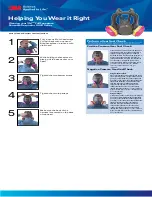
13
NOTE
When properly adjusted, the headstrap hub should be centered on the
back of your head, and the lower straps should be below your ears.
OPTI-FIT FACEPIECE WITH HEADNET
Inspect the respirator as described in Section XII.
1.
Fully loosen all straps.
2.
Place your chin against the chin cup and center the facepiece on your face.
3.
Hold the facepiece against your face,and pull the headnet over your head.
4.
Tighten the two lower straps and the temple straps until a good seal is ob-
5.
tained and all the headstraps lie flat on your head. Flatten the headnet with
a wiping motion toward the back of your head. Retighten the adjustment
straps. Do not overtighten the straps.
NOTE
When properly adjusted, the lower straps should be below your ears.
VII. HOW TO FIT CHECK THE RESPIRATOR
You must perform the following fit check each time the respirator is worn or before
entering the contaminated area.
WARNING
If a leak-tight seal is not obtained during the following fit check, do not
wear the respirator. Ask your supervisor or safety professional for assis
-
tance. The failure to comply with this warning may lead to personal injury,
illness, or death.
You must perform the following fit check each time the respirator is worn or before
entering a contaminated area.
A. Positive Pressure Fit Check:
Hold the palm of your hand gently over the
exhalation valve outlet of the nozzle cover. Do not distort the natural shape of the
facepiece. Exhale gently and hold your breath to create and maintain a slight posi-
tive pressure inside the facepiece. If air leakage occurs, readjust the facepiece and
headstraps, then retest.
B. Negative Pressure Fit Check:
Cover the inlet of the cartridges and/or filters
with the palms of your hands or another suitable item, such as a thin sheet of plas-
tic or rubber. When the respirator is equipped with cartridges, filter retainers may
be used as an aid. Alternatively, the cartridges may be removed to perform the fit
check. If removed, Sperian recommends someone other than yourself reinstall
them after a leak-tight fit is achieved. It is difficult for the wearer to reinstall the
cartridges without disturbing the facepiece-to-face seal and to determine whether
the cartridges are correctly seated against the facepiece. It is your responsibility
to ensure that the facepiece-to-face seal is not disturbed when reinstalling the car-
tridges and that each cartridge is sealed against the facepiece. Inhale gently and
hold your breath to slightly collapse the facepiece. If air leakage occurs, readjust
the facepiece and headstraps, then retest. If filter retainers are used, do not re
-
move them after the fit check is completed. Removing the filter retainers may shift
the facepiece and break the facepiece-to-face seal.
Summary of Contents for SURVIVAIR Opti-Fit S-Series
Page 22: ...22 www sperianprotection com...






























